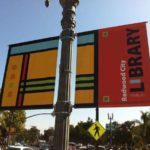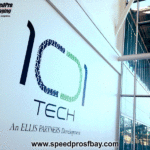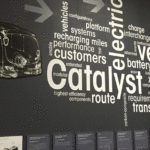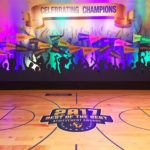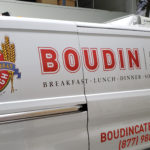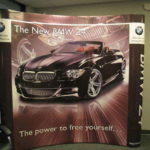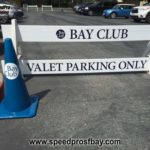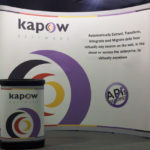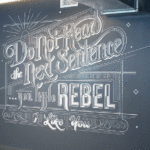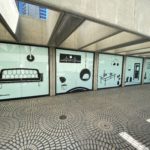
EXPERIENTIAL GRAPHICS: THE TOP 9 BAY AREA TRENDS OF 2019
FEBRUARY 9, 2019| SpeedPro of SF PeninsulaThe marketing buzzword of 2019 is experiential marketing. Not only is there a trend of millennials choice of “experiences” over material goods spilling over into other generations, but it is also hitting how marketers interact with consumers.
Marketers know it isn’t just about product + branding anymore. Each touchpoint with consumers – from the first ad they see through to the consumption of the product – matters. Marketers are tasked to cut through the clutter to create a fully branded experience, not just with push products or services. Best-in-class brands speak to their consumers through their preferred medium, elevating customer service and building positive interaction that fosters ongoing loyalty. An emerging vessel of experiential marketing is brand activation through a visual medium.
Brand activation means engaging consumers in a memorable way that forms long-term emotional connections. To that end, these are nine trends we see achieving widespread adoption in 2019:
1. Interactive Graphics
Bring people together through interactive environmental graphics. Wall murals, artwork and displays can turn into community events when you invite others to draw, color, sign and share messages through visual displays.
When the Special Olympics was in Chicago this summer, our sister SpeedPro Chicago Loop created a 20’ canvas which offered a color-by-number-inspired template for attendees to color and connect with each other and the organization while paying tribute to the games.
Engagement marketing needs to embrace authenticity when interacting with the consumer. The Special Olympics event is an example of a hands-on, one-to-one experiential project that draws onlookers and media attention.
Brands seeking authentic connections with their audiences are increasingly identifying this type of experiential graphics to blast through the digital noise, create meaningful personal engagement and generate earned media to further draw attention to the organization.
2. Pop-Up Retail Brand Activations
Pop up shops, bars, salons and more are cropping up everywhere. It’s a splashy limited-time-only promotional idea that draws in new customers, as well as deepens customer loyalty.
Businesses can transform a commercial space into a brand activation platform by creating an immersive brand experience. For example, we were brought on by an LA based experiential agency to create a downtown San Francisco “pop-up” space for Royal Dutch Airlines -KLM. Huge window graphics lured onlookers, and the interior spaces featured everything from a kid’s play area to a First Class cabin re-creation…and of course the espresso bar!
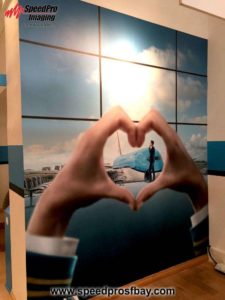
Although pop-up concepts aren’t new, brands are finding new applications, particularly with traditionally e-commerce companies finding partnerships with brick-and-mortar locations to give their customers a new experience and face-to-face interaction.
3. Digitized Hand-Drawn Artwork – Digitally Printed Wallpaper
Engagement marketing needs to embrace authenticity when interacting with their target audiences.
The University of California at San Francisco Benioff Children’s Hospital of Oakland recently built a new outpatient center for children and their family members. They enlisted the help of a local SpeedPro studio.
The studio used artwork that was created by kids who had stayed at the hospital to design nearly 80 wall murals. All of the artwork was small scale, hand-drawn painted pieces on 8.5” x 11” paper.
The artwork was digitized through a high-quality scanner and printed off each piece at roughly 12.5 feet wide and at varying heights to install them as wall murals in more than 70 rooms throughout the hospital. The texture of the watercolors on paper in the scanned digital file came through on the final product, adding a deeper level of authenticity to the project.
The artwork transforms the spaces from ordinary – or even cold – into something welcoming, comforting and familiar. It’s a tactic that we anticipate brands from multiple verticals integrating in the coming year.
4. Smartphone Imagery that Holds Up when Blown Up
Let’s face it – consumers can spot generic stock imagery from a mile away. One of the biggest trends in graphic design and branding in the coming year is a shift toward authentic imagery that seamlessly integrates into a business’s marketing campaigns.
There had previously been significant obstacles preventing anyone outside of a professional photographer from capturing an image that’s sufficiently high-quality enough to blow up on a wide-format printing scale.
However, the technology in smartphones has rapidly developed to the point where the images captured are as good as many professional cameras. As a result, the perceived barriers to using consumer technology in a business context have all but been erased.
The client had taken a picture at night of the San Francisco-Oakland Bay Bridge, which is an iconic image that local residents immediately know. The wall was 60′ wide by 14′ tall. Up close, the pixels were 1/2” – 3/4″ wide, but from the center of the room, they virtually disappeared. At 20 or more feet away from the wall, where the dance studio members would spend the majority of their time, the image spectacularly showcases an indelible part of the East Bay culture and environment.
What this illustrates is businesses of all sizes can take images they’ve created – instead of relying on stock imagery – to foster an authentic experience in multiple environments.
5. Dimensional Lettering and Contour Cut Signage
Environmental graphics are about transforming spaces to help connect people to a specific place. And innovative uses of technology are opening up a world of options for marketers.
The combination of a flatbed printer and special computer-controlled contour cutting (CNC) machines opens up endless opportunities for customized signage décor and other products utilizing wood, acrylic, aluminum – the list goes on. The CNC allows SpeedPro studios to contour cut virtually any shape and size, whether it be dimensional letters or décor that requires multiple materials.
For example, brands can create branded furniture or standees for a brand activation using a wide range of materials, including wood, metal, Foam board and a variety of others. Or companies can create Instagram-worthy moments, like when a SpeedPro studio built a larger-than-life-size version of the American Marketing Association’s logo during the organization’s annual conference. Impossible to miss, this 3D signage also served as a focal point for selfies and group photos throughout the event.
These innovative applications of wide-format printing transcend flat graphics and help brands immediately capture their audience’s attention. And as a growing number of large format graphics studios offer contour cut signage, the more brands will be able to unlock ways to activate their target audiences.
6. Custom Point-of-Purchase
Point of purchase (POP) displays used to be cookie-cutter units of functionality to display products, but now organizations are taking these displays to the next level and using them to convey the personality of the brand.
For example, our sister SpeedPro studio in Atlanta recently did a project for San Francisco based Salesforce, creating branded POP displays. The Silicon Valley brand’s mascots are a mixture of cartoonish creatures and people, and for this particular project, the SpeedPro team built 8’ bears as POP displays that can be used either temporarily or permanently, depending on the need.
We have provided multiple unique POP displays and custom graphics for the DFS duty free shops at San Francisco International Airport. From a chocolate tasting station for Godiva to a “world travelers den” for Johnnie Walker,
Along with the ever-expanding list of creations that digital cutting tables (CNC machines) can help brands create, custom branded POP displays will increasingly be just another weapon in brands’ marketing arsenal to capture their audience’s attention.
7. Textures and Textiles
With so much effort placed on creating digital environments, what many people lack is that tangible element that connects them with brands, establishes a tactile experience and catalyzes meaningful memories.
Through experiential marketing and environmental graphics, there is a multitude of opportunities with new materials, different machines and new fabrics to transform a space now. In concert with architectural design, artwork and visual graphics play a big role in helping brands encourage a fully sensory engagement with a brand and specific space.
For a growing number of brands, wall coverings are the ideal solution. As opposed to the standard vinyl wall mural material that uses an adhesive during application, wall coverings are a textile that’s printed in panels and put up with glue. It uses a variety of textures, including suede, plaster, smooth and PVC free, which school systems and hospitals require.
With respect to materials, felt is increasingly popular. When applied to a wall, it helps environmental graphics take on something akin to a three-dimensional feel – people walk up and think it’s a wall mural, but it’s actually felt.
It has an acoustic component to it, as well, if brands have concerns or special needs with respect to noise levels. For companies with open office formats, felt panels can be made into a variety of shapes and sizes to not only add a visual aesthetic to the business environment but also reduce sound levels.
8. 3D Wall Murals and Coverings
Brands looking to add a dynamic element to a specific environment – whether it be an office or a retail space – frequently turn to wall murals and coverings. However, there’s a growing push for environmental graphics that integrate a three-dimensional element that’s not simply eye-catching but fits a brand’s identity and communicates a message, as well.
For example, one SpeedPro studio recently worked on a rebrand with Hewlett-Packard at their Customer Welcome Center. The tech company sought out a solution that would help them create a look and feel that represents their brand – and create a cohesive aesthetic.
Initially, HP enlisted a graffiti artist to create the imagery for a 40-foot wall. The SpeedPro Marin (with support from us) printed a 25-foot textured wall covering as a black brick façade that looks like it was painted 20 years ago. The combination of graffiti-style artwork with the textured wall covering conveyed a hip, forward-thinking brand that has its finger on the pulse of technology and pop culture. At the same time, there’s a 10’ x 6’ screen in the center of the wall to do presentations.
When guests walk in, it truly makes a statement.
9. Treat Space as Branding Real Estate
Think of any open surface as an opportunity for another touchpoint with your consumer to create your entire brand experience. The floor can be an interesting design element or a billboard to catch the eye of those glued to smartphones. A ceiling doesn’t have to be a blank space. A door or a mirror can be a catalyst for a branded experience. After all, grabbing attention is the whole point so the more outrageous, the better.
Determining Your Needs for Experiential Graphics in 2019
Any investment in experiential graphics must be weighed against your business’s ultimate goal and how the project aligns with your objectives.
The most critical element of environmental graphics that has been developing over the past year is authenticity. Experiential graphics will only work if they honestly reflect your business and brand. Investing in engagement marketing tactics using interactive graphics has to be relevant and meaningful to resonate with your specific audience.
At SpeedPro of SF Peninsula, we are your wide-format printing partner when devising a strategy to push the envelope of what experiential graphics can do for your brand. Check us out at: www.speedpro.com/san-francisco-peninsula

